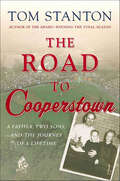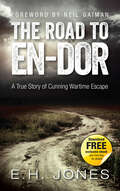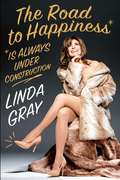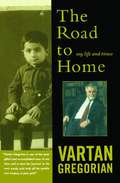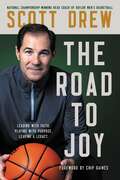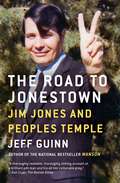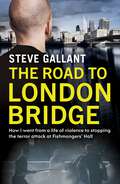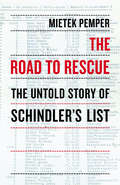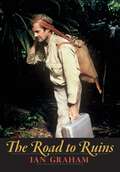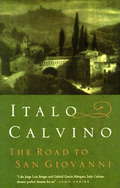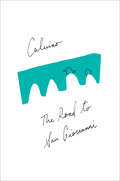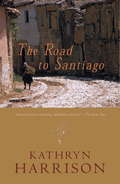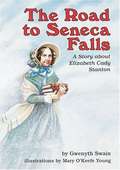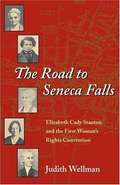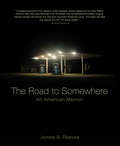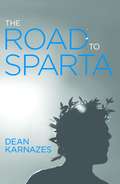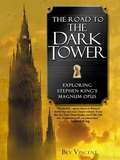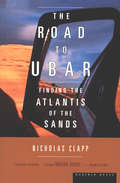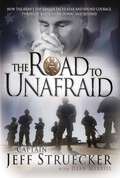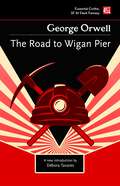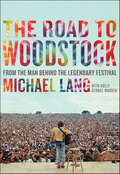- Table View
- List View
The Road to Cooperstown: A Father, Two Sons, and the Journey of a Lifetime
by Tom StantonAs he did with his award-winning book, The Final Season, Tom Stanton again tells a magical tale of fathers, brothers, and baseball heroes certain to resonate with sports fans everywhere. Every true baseball fan dreams of visiting Cooperstown. Some make the trip as boys, when the promise of a spot in the lineup with the Yankees or Red Sox or Tigers glows on the horizon, as certain as the sunrise. Some go later in life, long after their Little League years, to glimpse the past, not the future. And still others talk of somedays and of pilgrimages that await. For Tom Stanton, the trip took nearly three decades. The dream first grabbed hold of him in 1972, in the era of Vietnam and Watergate and Johnny Bench and the Oakland Athletics. Stanton, then an eleven-year-old Michigan boy who lived for the game, became fascinated by the National Baseball Hall of Fame, the sport's spiritual home, the place to which great players aspire. He plotted ways to convince his father to take him to the famous village along Lake Otsego. But his plans for that season never materialized. They disappeared in the turmoil caused by his mother's life-threatening illness and his brother's antiwar activities. Still, the dream lingered through the summers that followed. Twenty-nine years later, he invited the two men who had introduced him to the sport, his elderly father and his older brother, to join him on a trip to the Hall. Finally, they embarked on their long-delayed adventure. The Road to Cooperstown is a true story populated with colorful characters: a philanthropic family that launched the museum and uses its wealth to, among other things, ensure that McDonald's stays out of the turn-of-the-century downtown; the devoted fan who wrote a book to get his hero into the Hall of Fame; the Guyana native who grew up without baseball but comes to the induction ceremony every year; the librarian on a mission to preserve his great-grandfather's memory; the baseball legends who appear suddenly along Main Street; and the dying man who fulfills one of his last wishes on a warm day in spring. This adventure, though brief, provides a true bonding experience that is the heart of a sweet, one-of-a-kind book about baseball, family, the Hall of Fame, and the town with which it shares a rich heritage.
The Road to En-dor: A True Story Of Cunning Wartime Escape
by Neil Gaiman E. H. JonesThe incredible true story of two WWI POWs who used amateur magic to convince their captors that they were in touch with the spirit worldCaptured during World War I, Lieutenant E. H. Jones, a Welsh officer in the Indian Army, and Lieutenant C. W. Hill, an Australian serving in the R.A.F., were prisoners of war at the Yozgad prison camp in Turkey. Duty-bound as officers to attempt to escape, Jones sensed that what had previously been the harmless fun of fooling around with a homemade Ouija board could be turned into something much more productive. Playing on the credulous nature of their captors, Hill and Jones weaved an incredibly elaborate plot, hatched to plan their escape. Acting as mediums for the Ouija board, they attempted to convince their captors that they were gradually descending into insanity—which, had it been true, would have seen them repatriated. A true story of bravery, dedication, and extreme hardship, this book is a fascinating insight account of a daring escapade. As well as containing astonishing original materials including photographs, letters, and postcards, the book contains a preface by the author's grandson, as well as a foreword by Neil Gaiman who is linked to a film which is currently in pre-production. A free companion ebook is available to download from the Hesperus website (www.hesperuspress.com/the-road-to-en-dor) which includes back stories on the characters, maps, letters,and coded messages; and an exclusive short story written by Jones.
The Road to Happiness Is Always Under Construction
by Linda GrayTo celebrate her 75th birthday, Linda Gray, the iconic star of Dallas and timeless beauty, is sharing her road map to happiness in her revelatory memoir.When Linda Gray, iconic star of Dallas, was twenty years old, a magazine editor coldly rejected her as a model, writing that, perhaps one day, "you might shape into something." Since then, Linda has been evolving and growing, and has shaped into a role model for women of every age in her grace, beauty, generosity, and wisdom. She's been through more pain and tragedy than her longtime fans realize, having suffered paralyzing polio as a child, growing up with an alcoholic mother, landing in a emotionally abusive marriage at twenty-two and living by her husband's rules for sixteen years before she openly rebelled against him to take an acting class. At thirty-eight, Linda got her big break, as Larry Hagman's wife on Dallas. With fame came a bitter, public divorce, trouble at home with her two kids, and the loss of her beloved sister to breast cancer. Linda got through it all--the challenges of sexism in Hollywood and the pressures of being a single working mom--with a relentlessly positive attitude that kept her cruising, with a few speed bumps, to the place of serenity she thrives in now. To celebrate her seventy-fifth birthday, Linda is opening up about her life for the first time. Inside this book, she tells deeply personal stories with wit, humor, and candor, and reveals how she's learned to love every day as the blessing it is and to treat herself with the kindness she bestows on friends and strangers alike. Along with wisdom, Linda has accumulated a lot of practical tips about maintaining a healthy lifestyle--how to strengthen and detoxify your body, liberate your mind, and uplift your soul--and shares them as well. Her message to "give, love, and shine, baby, shine" will fill anyone with inspiration to live life to the fullest, and never stop pursuing honesty and joy.
The Road to Home
by Vartan GregorianIn this humorous, learned, and moving memoir, Vartan Gregorian recounts his journey from an impoverished childhood as a Christian Armenian in Muslim Tabriz to cultured citizen of the world. Gregorian's odyssey begins in an obscure poor quarter of a provincial city (thought by some to be the location of the Garden of Eden). Childhood centered on his brilliant, beloved, illiterate grandmother who taught him so much, the beauty of Church, school, American movies, and the larger world he read about in his borrowed books. From there, he continued on to a Beirut lycée, Stanford University, and the presidencies of the New York Public Library, Brown University, and Carnegie Corporation. Like Jimmy Carter in An Hour Before Daylight, and in the tradition of Nabokov, Jill Ker Conway, and V. S. Naipaul, he tells us that education is an openness to everything, and describes his public and private life as one education after another. This is a love story about life.
The Road to J.O.Y.: Leading with Faith, Playing with Purpose, Leaving a Legacy
by Scott DrewScott Drew, head basketball coach of the NCAA National Championship-winning Baylor Bears, rebuilt a program mired in scandal by instilling a culture of putting Jesus first. More than a book about basketball, this is a road map for leading with, and living out, your faith in any context--in sports, in business, and in life.Nearly seventeen million viewers tuned into the 2021 NCAA National Championship to see the Baylor Bears, led by head coach Scott Drew, beat the top-ranked Gonzaga Bulldogs, who were undefeated heading into the championship game. The win was Baylor&’s first National Championship--the culmination of the biggest turnaround in college sports history. When Drew accepted the head coaching position at Baylor in 2003, the job was arguably the worst in all of college sports. The men&’s basketball team had been disgraced by scandal: one player murdered a teammate, and the head coach who lied about the details tried to conceal illegal cash payments to his players, including a false allegation that the murdered player had been dealing drugs. It was an unprecedented story and a national embarrassment. Still, Coach Drew had a confident vision of what the program could be, even in the face of such adversity, and he guided his team to the pinnacle of success while leading with, and living out, his faith. The Road to J.O.Y. shares:Biblical principles that have helped Coach Scott Drew lead well through challenging timesAn insider&’s look at the others-first culture that spurred Baylor&’s reboundCoach&’s wisdom for investing in others and creating a successful organizationThe leadership lessons Drew has learned from growing up in a famous basketball family and years of coachingHow faith is the foundation for everything Drew does With equal parts inspirational memoir and personal and professional growth, The Road to J.O.Y. is perfect for anyone who is looking to better live out their faith, lead a team, achieve a goal, or mentor others.
The Road to Jonestown: Jim Jones and Peoples Temple
by Jeff GuinnAn Edgar Award Finalist for Best Fact Crime &“A thoroughly readable, thoroughly chilling account of a brilliant con man and his all-too vulnerable prey&” (The Boston Globe)—the definitive story of preacher Jim Jones, who was responsible for the Jonestown Massacre, the largest murder-suicide in American history, by the New York Times bestselling author of Manson.In the 1950s, a young Indianapolis minister named Jim Jones preached a curious blend of the gospel and Marxism. His congregation was racially mixed, and he was a leader in the early civil rights movement. Eventually, Jones moved his church, Peoples Temple, to northern California, where he got involved in electoral politics and became a prominent Bay Area leader. But underneath the surface lurked a terrible darkness. In this riveting narrative, Jeff Guinn examines Jones&’s life, from his early days as an idealistic minister to a secret life of extramarital affairs, drug use, and fraudulent faith healing, before the fateful decision to move almost a thousand of his followers to a settlement in the jungles of Guyana in South America. Guinn provides stunning new details of the events leading to the fatal day in November, 1978 when more than nine hundred people died—including almost three hundred infants and children—after being ordered to swallow a cyanide-laced drink. Guinn examined thousands of pages of FBI files on the case, including material released during the course of his research. He traveled to Jones&’s Indiana hometown, where he spoke to people never previously interviewed, and uncovered fresh information from Jonestown survivors. He even visited the Jonestown site with the same pilot who flew there the day that Congressman Leo Ryan was murdered on Jones&’s orders. The Road to Jonestown is &“the most complete picture to date of this tragic saga, and of the man who engineered it…The result is a disturbing portrait of evil—and a compassionate memorial to those taken in by Jones&’s malign charisma&” (San Francisco Chronicle).
The Road to London Bridge: How I went from a life of violence to stopping the terror attack Fishmongers’ Hall
by Steve Gallant'Steve Gallant's exceptional act of courage on London Bridge speaks of both heroism and redemption' - Jon Snow, former anchor of Channel 4 NewsThis is a story of physical bravery, moral courage, and the power of redemption from the man who led the charge in stopping the terrorist attack at Fishmongers' Hall in November 2019. From cell fires to violent feuds and gang battles on prison wings, after being sentenced to life imprisonment for murder, what Steve witnessed at HMP Frankland made him change his life forever. After losing everything, he vowed to never use violence again. In November 2019, Steve's redemptive journey led him to a Learning Together event at Fishmongers' Hall, hosted by his mentor, Jack Merritt, and attended by Saskia Jones. It was here, on his first day out of prison on day release, that Steve was forced to break his vow as he bravely confronted and fought armed-terrorist Usman Khan on London Bridge. Armed just with a narwhal tusk, Steve wrestled and held Khan to the ground while he waited for the police to arrive.In October 2020 Steve was granted a royal prerogative of mercy in recognition of his actions at London Bridge. In August 2021 he was released from prison and in March 2023 he was awarded a Queen's Gallantry Medal, the final civilian gallantry awards approved by the late Queen.This is Steve Gallant's powerful and inspiring story of redemption told in full for the first time.
The Road to London Bridge: How I went from a life of violence to stopping the terror attack Fishmongers’ Hall
by Steve Gallant'Steve Gallant's exceptional act of courage on London Bridge speaks of both heroism and redemption' - Jon Snow, former anchor of Channel 4 NewsThis is a story of physical bravery, moral courage, and the power of redemption from the man who led the charge in stopping the terrorist attack at Fishmongers' Hall in November 2019. From cell fires to violent feuds and gang battles on prison wings, after being sentenced to life imprisonment for murder, what Steve witnessed at HMP Frankland made him change his life forever. After losing everything, he vowed to never use violence again. In November 2019, Steve's redemptive journey led him to a Learning Together event at Fishmongers' Hall, hosted by his mentor, Jack Merritt, and attended by Saskia Jones. It was here, on his first day out of prison on day release, that Steve was forced to break his vow as he bravely confronted and fought armed-terrorist Usman Khan on London Bridge. Armed just with a narwhal tusk, Steve wrestled and held Khan to the ground while he waited for the police to arrive.In October 2020 Steve was granted a royal prerogative of mercy in recognition of his actions at London Bridge. In August 2021 he was released from prison and in March 2023 he was awarded a Queen's Gallantry Medal, the final civilian gallantry awards approved by the late Queen.This is Steve Gallant's powerful and inspiring story of redemption told in full for the first time.
The Road to Rescue: The Untold Story of Schindler's List
by Mietek Pemper“Don’t thank me for your survival, thank your valiant Stern and Pemper, who stared death in the face constantly.”—Oskar Schindler in a speech to his released Jewish workers in May 1945.Steven Spielberg’s Oscar-winning film Schindler’s List popularized the true story of a German businessman who manipulated his Nazi connections and spent his personal fortune to save some 1,200 Jewish prisoners from certain death during the Holocaust. But few know that those lists were made possible by a secret strategy designed by a young Polish Jew at the Płaszow concentration camp. Mietek Pemper’s compelling and moving memoir tells the true story of how Schindler’s list really came to pass.Pemper was born in 1920 into a lively and cultivated Jewish family for whom everything changed in 1939 when the Germans invaded Poland. Evicted from their home, they were forced into the Krakow ghetto and, later, into the nearby camp of Płaszow where Pemper’s knowledge of the German language was put to use by the sadistic camp commandant Amon Goth. Forced to work as Goth’s personal stenographer from March 1943 to September 1944—an exceptional job for a Jewish prisoner—Pemper soon realized that he could use his position as the commandant’s private secretary to familiarize himself with the inner workings of the Nazi bureaucracy and exploit the system to his fellow detainees’ advantage. Once he gained access to classified documents, Pemper was able to pass on secret information for Schindler to compile his famous lists. After the war, Pemper was the key witness of the prosecution in the 1946 trial against Goth and several other SS officers. The Road to Rescue stands as a historically authentic testimony of one man’s unparalleled courage, wit, defiance, and bittersweet victory over the Nazi regime.
The Road to Roses: Heartbreak, Hope, and Finding Strength When Life Doesn't Go as Planned
by Desiree Hartsock SiegfriedWhen Desiree Hartsock was offered the opportunity to star on The Bachelorette, she thought she was finally getting the life she always longed for. Yet her reality TV dreams gave way to rough roads of unexpected twists, public scrutiny, and rejection. Now for the first time, Desiree reveals in this rivetingly honest book how she found her resilience and love after all--and you can too. Desiree Hartsock was living paycheck to paycheck and freshly--not to mention painfully--single when she first stepped onto the set of The Bachelor. Then when she was selected to star as The Bachelorette, she thought surely this turn of events promised a second chance. Yet Desiree's debut on the world stage also meant facing the critics, as viewers judged her every word and action. She was devastated when Brooks broke up with her and the entire world observed her humiliation. But what the world didn't see was the comeback journey that followed. The Road to Roses reveals: The emotional journey behind the events that played out on cameraThe mindset changes that kept Desiree open to love and trust even after heartbreak, that ultimately led her to choosing her husbandAnd the off-camera journey of the lessons Desiree learned, like how to always fail forward, stay true to yourself, and trusting that despite the external pressures, God loves us just as we areFor anyone who is looking at the pieces of their lives and losing hope that they can be put back together again, The Road to Roses offers an authentic guide for finding your grit to keep going and make yourself proud no matter what pressures you face. Whether your heart has been broken, your dream has been put on hold, or your character is being put under pressure, following Desiree's journey will give you courage to stay strong in your own.
The Road to Ruins
by Ian GrahamFor anyone who ever wanted to be an archaeologist, Ian Graham could be a hero. This lively memoir chronicles Graham's career as the last explorer and a fierce advocate for the protection and preservation of Maya sites and monuments across Mexico, Guatemala, and Belize. It is also full of adventure and high society, for the self-deprecating Graham traveled to remote lands such as Afghanistan in wonderful company. He tells entertaining stories about his encounters with a host of notables beginning with Rudyard Kipling, a family friend from Graham's childhood.Born in 1923 into an aristocratic family descended from Oliver Cromwell, Ian Graham was educated at Winchester, Cambridge, and Trinity College, Dublin. His career in Mesoamerican archaeology can be said to have begun in 1959 when he turned south in his Rolls Royce and began traveling through the Maya lowlands photographing ruins. He has worked as an artist, cartographer, and photographer, and has mapped and documented inscriptions at hundreds of Maya sites, persevering under rugged field conditions. Graham is best known as the founding director of the Corpus of Maya Hieroglyphic Inscriptions Program at the Peabody Museum of Archaeology and Ethnology, Harvard University. He was awarded a MacArthur Foundation genius grant in 1981, and he remained the Maya Corpus program director until his retirement in 2004.Graham's careful recordings of Maya inscriptions are often credited with making the deciphering of Maya hieroglyphics possible. But it is the romance of his work and the graceful conversational style of his writing that make this autobiography must reading not just for Mayanists but for anyone with a taste for the adventure of archaeology.
The Road to San Giovanni
by Tim Parks Italo CalvinoThis major testament by Italo Calvino is composed of of five strikingly elegant "memory exercises" about his life and work. The title piece, "The Road to San Giovanni," poignantly evokes his childhood home. "A Cinema-Goer's Autobiography" tells of his adolescence, when he was riveted by American films starring Gary COoper, Clark Gable, and others. "Memories of a Battle" is at once a reminiscence of his experience ina partisan unit during World War II and a reflection on the rolse of real and imagined memories. "La Poubelle Agréée"is a Parisian set piece, and "From the Opaque" is essentially his writer's credo. InThe Road to San Giovanni,brilliantly translated by Tim Parks, the originality, grace, wit, and wisdom that we have come to associate with Calvino are everywhere on display.
The Road to San Giovanni
by Italo CalvinoFrom the Italian author, personal essays featuring his relationship with his father, his love of movies, and fighting fascism during World War II. &“In each other&’s presence we became mute, would walk in silence side by side along the road to San Giovanni. To my father&’s mind, words must serve as confirmations of things, and as signs of possession; to mine, they were foretastes of things barely glimpsed, not possessed, presumed.&” —from The Road to San Giovanni In these autobiographical essays, published after Italo Calvino&’s death, the intellectually vibrant writer not only reflects on his own past but also inquires into the very workings of memory itself. From the title essay&’s lyrical evocation of the author&’s relationship with his father, and a charming account of teenage years spent in the glow of the cinema screen, to Calvino&’s reminiscences of his experiences in the Italian Resistance during World War II and of his years in Paris, to his declaration of purpose as a writer in the final essay&’s visionary fragments, these five &“memory exercises&” are heartfelt, affecting, and wise.Praise for The Road to San Giovanni&“Brimming with Calvino&’s beautifully crafted prose, dry humor, and continual questioning . . . Calvino has been very well served by his translator, Tim Parks.&” —Observer&“In five elegant &“memory exercises&” written between 1962 and 1977, Italian fiction writer Calvino (1923-85) presents an affecting self-portrait and offers indirect insights into how he conjured up his imaginary worlds . . . . This sparkling translation concludes with Calvino's lyric, metaphorical, highly elliptical description of his creative process.&” —Publishers Weekly
The Road to Santiago
by Kathryn HarrisonOvercome by the scenic beauty, Harrison threw open the hotel-room window shutters and exclaimed, "Look at the mountains!" From behind her, 12-year-old Sarah ecstatically waved the television's remote control and shouted, "French MTV!" So began a voyage distinguished by a mother getting to know herself through her daughter. For hundreds of years, thousands of worshipers have trekked, like this mother and daughter, on foot, the 400 miles from St.-Jean-Pied-de-Port, France, to the sacred shrine of the apostle James, the brother of Jesus. Everyone who endures the inhospitable weather, poor road conditions, and exhaustion does so not so much to enjoy the shrine as to survive the pilgrimage, a time-out-of-time penance. Harrison had taken the journey before, alone, and learned something about herself. Her account of her accompanied, reprise journey and what she learned, part of the National Geographic Directions travel series, endears with its wit and sensitivity.
The Road to Seneca Falls: A Story about Elizabeth Cady Stanton
by Gwenyth SwainA biography of suffragist Elizabeth Cady Stanton, one of the organizers of the country's first women's rights convention, which took place in Seneca Falls, New York, in 1848.
The Road to Seneca Falls: Elizabeth Cady Stanton and the First Woman's Rights Convention
by Judith WellmanIn the summer of 1848 some 300 women and men gathered in a church in the New York town of Seneca Falls and passed a series of resolutions pertaining to the rights of women. Among them was the radical idea that women should be allowed to vote, proposed by the main organizer of the convention, Elizabeth Cady Stanton. This book examines the factors that led up to the convention, woven together with the story of Cady Stanton's life.
The Road to Shine
by Laurie GardnerFor anyone who's ever sensed that there must be something more . . . let the adventure begin.Using her own personal, professional, and exotic travel experiences, Laurie Gardner shows how we can derive life-changing insights and essential personal growth from any situation. Most importantly, we discover how to connect with our deepest desires and our highest selves, learning to honor our own intuition and truth.Laurie Gardner has Harvard degrees in comparative world religions, psychology, and education. She dedicated her career to spearheading an international public school reform movement and is a master practitioner in body/mind/spirit wellness.
The Road to Somewhere: An American Memoir
by James A. ReevesA photo memoir of one man's travels through America that is as sprawling and chaotic as the country itself. One day James A. Reeves realized that he no longer understood his country or what he should be doing in it. There was a time when the road to manhood was clear--go to war, find a job with a big company, wear a tie, and start a family --but then the wars got strange and companies changed. He decided to go for a drive to clear his head. What resulted is a scattershot journey spanning five years, forty thousand miles, twelve speeding tickets, and several moments of unexpected kindness through the neon corridors and dark corners of America. Reeves drove along the back roads taking pictures and looking for answers, kept company by the nervous chatter of talk radio and the ambient drone of twenty-four-hour diners, as he drifted toward a slow reckoning with his own compulsions and unexpected loss.
The Road to Sparta: Reliving the Ancient Battle and Epic Run that Inspired the World's Greatest Foot Race
by Dean KarnazesThe Road to Sparta is the story of the 153-mile run from Athens to Sparta that inspired the marathon and saved democracy, as told--and experienced--by ultramarathoner and New York Times bestselling author Dean Karnazes. In 490 BCE, Pheidippides ran for 36 hours straight from Athens to Sparta to seek help in defending Athens from a Persian invasion in the Battle of Marathon. In doing so, he saved the development of Western civilization and inspired the birth of the marathon as we know it. Even now, some 2,500 years later, that run stands enduringly as one of greatest physical accomplishments in the history of mankind. Karnazes personally honors Pheidippides and his own Greek heritage by recreating this ancient journey in modern times. Karnazes even abstains from contemporary endurance nutrition like sports drinks and energy gels and only eats what was available in 490 BCE, such as figs, olives, and cured meats. Through vivid details and internal dialogs,The Road to Sparta offers a rare glimpse into the mindset and motivation of an extreme athlete during his most difficult and personal challenge to date. This story is sure to captivate and inspire--whether you run great distances or not at all.
The Road to Success Is Paved with Failure: How Hundreds of Famous People Triumphed Over Inauspicious Beginnings, Crushing Rejection, Humiliating Defeats and Other Speed Bumps Along Life's Highway
by Joey GreenDown on your luck? Don't despair. You might still be headed for a life of riches and renown. After all, consider the experiences of: * Marilyn Monroe, who in 1947, after one year under contract, was dropped by 20th Century-Fox because Darryl Zanuck thought she was unattractive * John Grisham, whose first novel, A Time to Kill, was rejected by sixteen agents and a dozen publishing houses * Walt Disney, whose first cartoon production company went bankrupt * Barbra Streisand, who made her stage debut at age 19 in a show that opened and closed in a single night * Edgar Allan Poe, who was expelled from West Point * Adlai Stevenson, who at age 12 accidentally killed a visitor to his parents' home on Christmas day This inspired compendium of pop culture and historical trivia will amuse and delight readers of all ages. It's a perfect gift for graduates, for moms and dads, and for anyone whose cheese has recently been moved.
The Road to The Dark Tower
by Bev VincentIn 1970, Stephen King embarked on what would become the crowning achievement in his literary career-the Dark Tower. The seven-volume series, written and published over a period of 30 years, was inspired by Robert Browning's poem "Childe Roland to the Dark Tower Came," as well as J. R. R. Tolkien's The Lord of the Rings, and the spaghetti Westerns of Sergio Leone. With the full cooperation of Stephen King himself, The Road to the Dark Tower examines the epic journey of the author to complete a story that threatened to overwhelm him. In this indispensable companion, Bev Vincent presents a book-by-book analysis of each volume in the series, tracing the Dark Tower's connections to King's other novels including The Stand, Insomnia, and Hearts in Atlantis, and offering insights from the author about the creative process involved in crafting his lifelong work-a work that has consumed not only Stephen King, but his legion of devoted readers. This is essential reading for any Dark Tower-or Stephen King-fan.
The Road to Ubar: Finding the Atlantis of the Sands
by Nicholas ClappThe author recounts his discovery of a lost Arabian city in this “captivating story of [a] stupendous archeological achievement” (Kirkus).No one thought that Ubar, the most fabled city of ancient Arabia, would ever be found, if it even existed. According to the Koran, the ancient trading outpost was sunk into the desert as punishment for the sins of its people. Over the centuries, many searched for the legendary “Atlantis of the Sands”—including Lawrence of Arabia—yet the city remained lost. Until now.Documentary filmmaker and amateur archaeologist Nicholas Clapp first stumbled on the legend of Ubar in the 1980s while poring over historical manuscripts. Filled with overwhelming curiosity, Clapp led two expeditions to Arabia with a team that included space scientists and geologists. In The Road to Ubar, he chronicles the grand adventure that led to a historic discovery.
The Road to Unafraid: How the Army's Top Ranger Faced Fear and Found Courage through
by Jeff StrueckerJeff Struecker, a "Black Hawk Down" hero, the Army's Top Ranger, now an Army Chaplain, relates his own tales from the frontlines of every U.S. initiative since Panama, and tells how God taught him faith from the front in fear-soaked times. As readers go on-mission with Struecker through his harrowing tales, they will learn how to face their own fears with faith in a mighty God. Just as he told one of his charges in Mogadishu: "The difference between being a coward and a hero is not whether you're scared, it's what you do while you're scared."
The Road to Wigan Pier (Essential Gothic, SF & Dark Fantasy)
by George OrwellA new edition of Orwell's early work, showing the origins of his commitment to social justice.A new edition of Orwell's early account of bleak working class life in the industrial culture of Yorkshire and Lancashire, which revealed the distinctions between the upper classes of the British Empire and the reality of the people who worked in the factories to drive wealth and prosperity for others, never to get a share for themselves. Published while Orwell was in Spain, the book highlights the political philosophy that led him to fight for the leftist forces in the Civil War.
The Road to Woodstock
by Michael Lang Holly George-WarrenThe definitive account of the most famous music festival of all time: Woodstock.“[A] vivid and lively account of those hectic and historic three days….The best fly-on-the-wall account, tantamount to having had a backstage pass to an iconic event.”—New York PostThe Woodstock music festival of 1969 is an American cultural touchstone, and no book captures the sights, sounds, and behind-the-scenes machinations of the historic gathering better than Michael Lang’s New York Times bestseller, The Road to Woodstock. USA Today calls this fascinating, entertaining, and blissfully nostalgic look back, “Invaluable.” In The Road to Woodstock, Michael Lang recaptures the magic for the generation that was there…and for the generations that followed.Just in time for the 50th Anniversary of the Woodstock festival, this definitive volume tells you everything you need to know about the most famous three days in music history.
